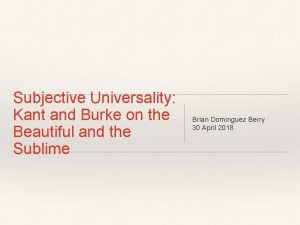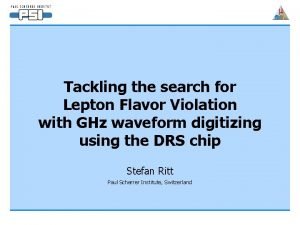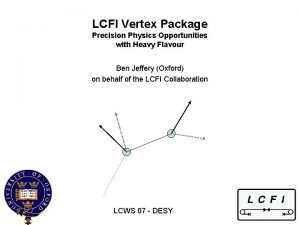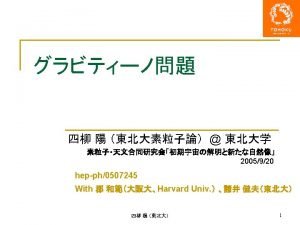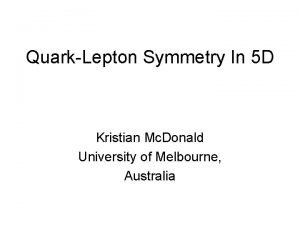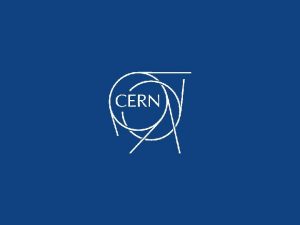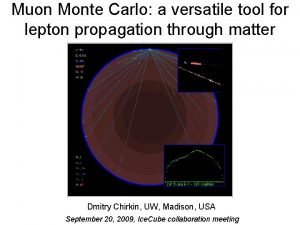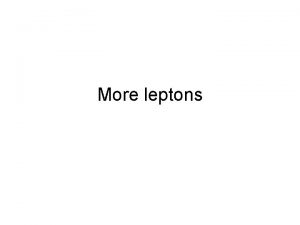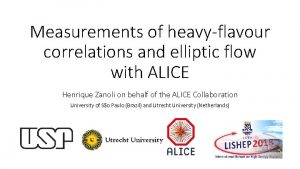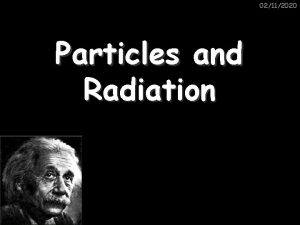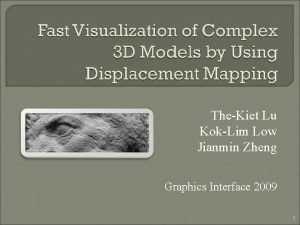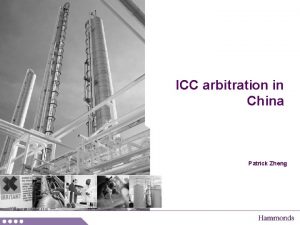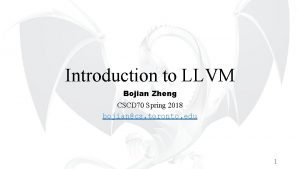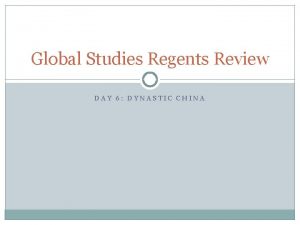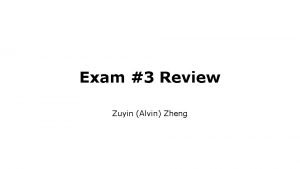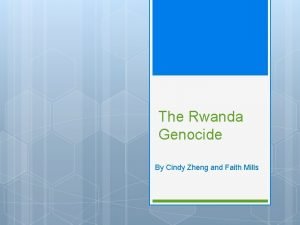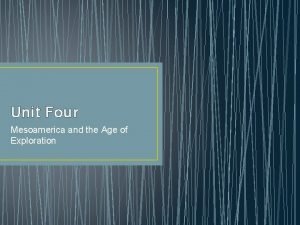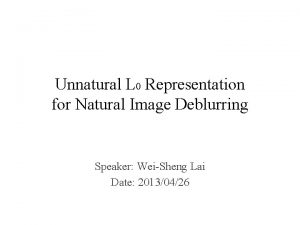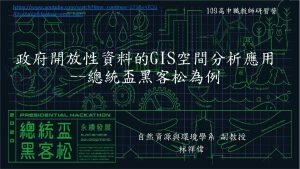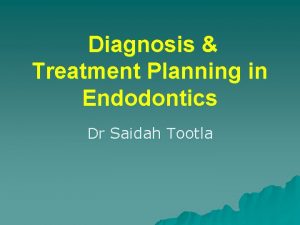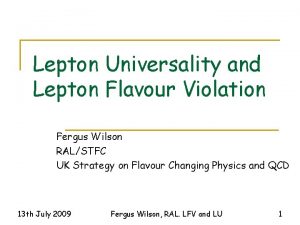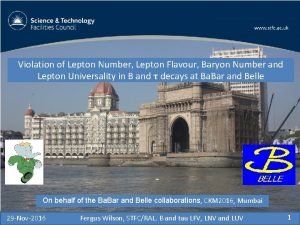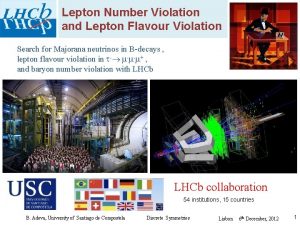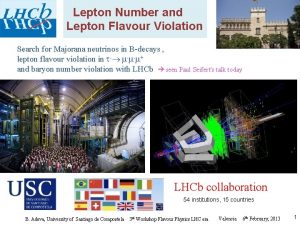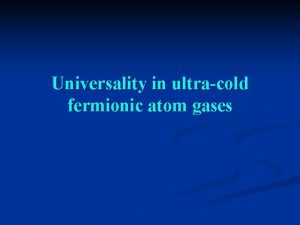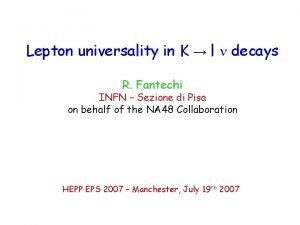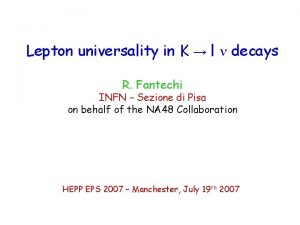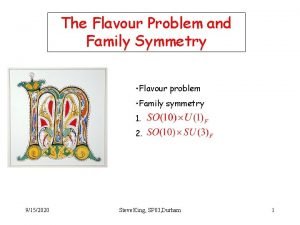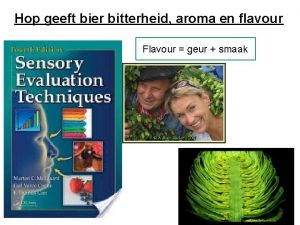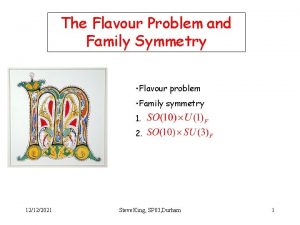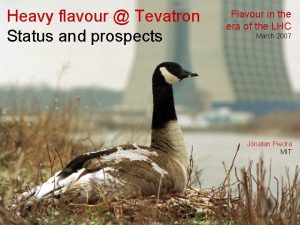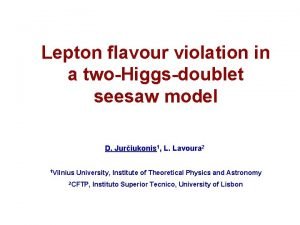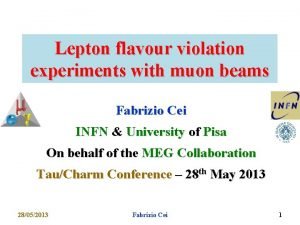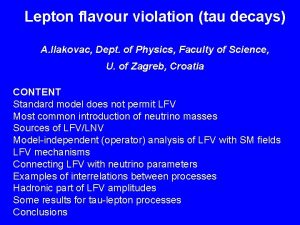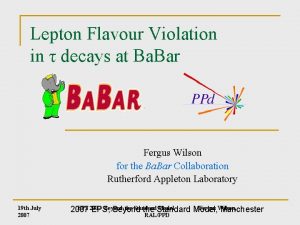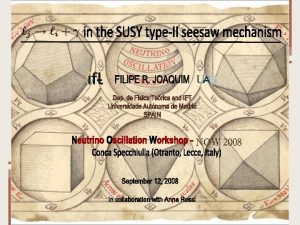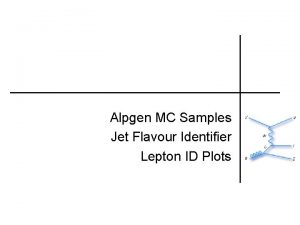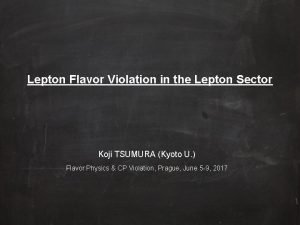Yangheng Zheng Lepton Flavour Universality tests using semitauonic






























- Slides: 30

Yangheng Zheng Lepton Flavour Universality tests using semitauonic decays in LHCb with t hadronic decays into 3 p 1 JIBO HE, WENQIAN HUANG, YANGHENG ZHENG GUY WORMSER UCAS, BEIJING AND LAL, CNRS/IN 2 P 3 , PARIS SACLAY UNIVERSITY FCPPL workshop, Shanghai, April 24

Talk outline 2 � PRL 120, 171802 (2018)/PRD 97, 072013(2018) FCPPL workshop, Shanghai, April 24

The unusual features of the LHCb analysis B 0 D*+t-n; t 3 p(p°) PRL 120, 171802 (2018)/PRD 97, 072013(2018) 3 �A semileptonic decay without (charged) lepton !!: ZERO background from normal semileptonic decays!!!! �In this analysis, it is the background that leads to nice mass peaks and not the signal !!! This provides key handle to control the various backgrounds �Only 1 neutrino emitted at the t vertex The complete event kinematics can be reconstructed with good precision � No sensitivity to t polarisation through but potentially still measurable !! P 3 p (ma 12 » 0. 5*mt 2) �Note : measure R(D*-) and not R(D*) as B Factories FCPPL workshop, Shanghai, April 24

The initial very large background 4 �The D*tn decay, with t going into 3 pions (it can also be 3 p+p 0) leads to a D* 3 p(+X ) final state �Nothing is more common than a D*3 p (+X ) final state in a typical B decay : BR(B 0 D*3 p+X)/BR(B 0 D*tn; t 3 p)SM~100 A very strong background suppression method is absolutely needed : The DETACHED VERTEX METHOD FCPPL workshop, Shanghai, April 24

Vertex topology of the usual B decay 5 FCPPL workshop, Shanghai, April 24

Selection: detached vertex 6 FCPPL workshop, Shanghai, April 24

Selection: the detached vertex method LHCb-PAPER-2017 -017/2017 -27 PRL 120, 171802 (2018)/PRD 97, 072013(2018) 7 LHCb Dz FCPPL workshop, Shanghai, April 24

The second level of background 8 �After the 4 s cut in Dz/s. Dz , the prompt background is suppressed by ~3 orders of magnitude!!!!! �The second level of background consists of B decays where the 3 p vertex is transported away from the B 0 vertex by a charm carrier: Ds, D+ or D 0 (in that order of importance) �This background is smaller : BR(B 0 ->D* ’D’; ‘D’ 3 p. X)/ BR(B 0 D*tn; t 3 p)SM~10 �… and we can suppress it strongly FCPPL workshop, Shanghai, April 24

The control channels Ds, D°, and D+ 9 D+ Anti-PID Ds Ds Run 1, 3 fb-1 D° Anti-Isolation LHCb-PAPER-2017 -017, PRL 120, 171802 (2018)/PRD 97, 072013(2018) FCPPL workshop, Shanghai, April 24

D*Ds+X events with reconstructed Ds in 3 p 10 �Clear separation obtained of the Ds, Ds* and Ds** components �Ratios ~1: 2: 2 (only 20% of Ds come directly from B) LHCb-PAPER-2017 -017, PRL 120, 171802 (2018)/PRD 97, 072013(2018) FCPPL workshop, Shanghai, April 24

Charged Isolation and PID 11 � LHCb software can attach a track passing nearby a vertex: very useful to tag D° � � � decays in K 3 p Necessity to reject also 5 prong Ds decays which are frequent when there is the combined presence of an h and h’ presence in the decay chain. Very efficient for D° decays which is often accompanied by 2 charged kaons, less for the D+ To keep the background low, we request only events with 1 combination Important to reject K- p+p+ events where the « negative » Kaon is taken as a pion Can be of course used a good control sample for D+ meson The presence of pp l events where the lepton from a semileptonic Ds decays is taken as pion FCPPL workshop, Shanghai, April 24

The anti-Ds BDT : 3 p dynamics, partial reconstruction and isolation 12 Min(mass(p+p-)) Max(mass(p+p-)) Neutral Isolation E(n) mass(D*+p-p+p-) LHCb-PAPER-2017 -027 PRL 120, 171802 (2018)/ PRD 97, 072013(2018) FCPPL workshop, Shanghai, April 24

The 3 fit projections (q 2, lifetime and BDT) 13 LHCb This shows the overall good quality of the fit PRL 120, 171802 (2018)/PRD 97, 072013(2018) FCPPL workshop, Shanghai, April 24 LHCb

Fit results LHCb-PAPER-2017 -017, LHCb-PAPER-2017 -027 PRL 120, 171802 (2018)/PRD 97, 072013(2018) 14 � The 3 D template binned likelihood fit results are presented for the lifetime and q 2 in four BDT bins. � The increase in signal (red) purity as function of BDT is very clearly seen, as well as the decrease of the Ds component (orange) � The dominant background at high BDT becomes the D+ component (blue) , with its distinctive long lifetime. � The overall c 2 per dof is 1. 15 FCPPL workshop, Shanghai, April 24

Systematic uncertainties table PRL 120, 171802 (2018)/PRD 97, 072013(2018) 15 FCPPL workshop, Shanghai, April 24

The new average PRL 120, 171802 (2018)/PRD 97, 072013(2018) 16 Combined signifance: 3. 8 s away from SM FCPPL workshop, Shanghai, April 24

New BELLE result presented at Moriond 2019 17 FCPPL workshop, Shanghai, April 24

Conclusion for R(D*) analysis 18 � The analysis to measure the ratio BR(B° D*tn)/BR(B° D*3 p) using the 3 p hadronic decay of the t lepton has been performed at LHCb (Preliminary) R(D*)=0. 291± 0. 019(stat) ± 0. 026(syst) ± 0. 013(ext) New preliminary LHCb average of R(D*)=0. 310± 0. 026 � This analysis was made possible due to the unique LHCb capabilities for separating secondary and tertiary vertices with unprecedented precision � The R(D*) result, the first one to use 3 p final state, is one of the best single measurements, having the smallest statistical error. � It is compatible both with the SM prediction and with the present WA. However, it slightly increases the discrepancy of the WA wrt to the SM FCPPL workshop, Shanghai, April 24

19 FCPPL workshop, Shanghai, April 24

20 �FCCPL project: UCAS (Prof. J. He, Prof. Y. Zheng , W. Huang)-LAL (GW) �Very important to test potential Lepton Universality in many channels �This channel has spin-1 spectator as the D*, but different feed-down properties, different longitudinal polarization � SM R(J/y) expectation should be the same (0. 27) - Not yet precisely computed because of the form-factors uncertainties �R(J/y) and R(D*) can be different in some NP scenarios FCPPL workshop, Shanghai, April 24

Characteristics of the R(J/y) channel 21 Good Points Bad points � High trigger efficiency � Low Bc production rate � Same dimuon trigger for signal (around 1% of B 0) � Low Bc lifetime (1/3 of B 0 ) and normalisation channel � High reconstruction efficiency and negligible background for the spectator hadron � The J/y vertex is the B vertex FCPPL workshop, Shanghai, April 24 � This last point is the more delicate: smaller difference in IP distribution for p from the PV and from Bc

Analysis flow identical to R(D*) 22 �Apply cleaning cuts with softer requirements The more delicate phase to balance purity vs efficiency. Given the small number of expected events, the background has to be dominated by double charm decays �Select events with inverted topology : z(3 p)-z(J/y)> 4 s �Use the same control channels : J/y Ds, J/y D+, J/y. D 0 � The Ds decay and production models can be re-used from R(D*) analysis �Same isolation and PID requirements FCPPL workshop, Shanghai, April 24

Normalisation channel(s) 23 Same final state: Bc J/y 3 p Direct R meas. : Bc J/ymn �Pros: Same final state Same trigger Small PID corrections Same analysis chain �Cons: Unmeasured absolute BR LHCb has measured ratios BR(J/y p)/BR(J/ymn) and BR(J/y 3 p)/BR(J/yp) FCPPL workshop, Shanghai, April 24 direct R measurement Analysis already performed in LHCb « Simple » 3 m channel �Cons : PID systematics do not cancel out Different selection and analysis chain

Control modes 24 � FCPPL workshop, Shanghai, April 24

Bc J/ymn channel 25 FCPPL workshop, Shanghai, April 24

Expectations and plans 26 � FCPPL workshop, Shanghai, April 24

Conclusion 27 �Bright future for semitauonic R measurements in LHCb �R(D*) for Run-II in preparation, statistical error around 5% �Intensive and challenging work on R(J/y) with a nice Chinese-French collaboration. Will go on with the help of FCPPL! Many thanks! �Other R() also being worked on ! FCPPL workshop, Shanghai, April 24

Importance of the normalization channel B° D*3 p 28 �Normalization mode as similar as possible to the signal to cancel production yield, BR uncertainties and systematics linked to trigger, PID, first selection cuts Run 1, 3 fb-1 17 k events LHCb-PAPER-2017 -017, PRL 120, 171802 (2018)/PRD 97, 072013(2018) FCPPL workshop, Shanghai, April 24

BABAR measurement of BR(B° D*3 p) (Phys. Rev. D 94 (2016), 091101 ) 29 � In PDG 2014 BR(B° D*3 p) known only to 11% precision � New BABAR analysis with full available statistics BR(B° D*3 p)= 0, 726± 0. 011± 0. 031)% WA =(0, 721± 0. 029)% PDG 2017 There is also an LHCb result of D*3 p/D*p not included in the PDG Phys. Rev. D 87, 092001 (2013) Dominated by systematics errors Good precision of 4. 0 % now with the new WA !! BELLE : Could you remeasure this very precisely as well !!! FCPPL workshop, Shanghai, April 24

LHCb Results LHCb-PAPER-2017 -017, PRL 120, 171802 (2018)/PRD 97, 072013(2018) 30 BR(B° D*tn)/BR(B° D*3 p)=1. 97± 0. 13(stat) ± 0. 18(syst) BR(B° D*+tn)=(1. 42± 0. 094(stat) ± 0. 129(syst)± 0. 054(ext))% to be compared with the PDG(2017) (1. 67± 0. 13 ) % (Using for BR(B° D*3 p) our average of (0, 721± 0. 028)%) New (naive) average BR(B° D*+t-n) =(1. 58± 0, 10)% R(D*)=0. 291± 0. 019(stat) ± 0. 026(syst) ± 0. 013(ext) Using the HFLAV BR(B° D*+m-n)=(4, 88± 0, 10)% Experiment Method N evts B D*tn N evts B° D*+t-n BABAR Leptonic hadronic tag 888± 63 245± 27 BELLE Leptonic hadronic tag 503± 65 0, 4 x 503=200 BELLE Single pi hadronic tag 88 ± 11 1296± 86 FCPPL workshop, Shanghai, April 24 LHCb 3 p Hadronic
 Leininger sunrise model
Leininger sunrise model Subjective universality
Subjective universality Lepton daisy
Lepton daisy Heavy flavour
Heavy flavour Lepton-photon
Lepton-photon Quark lepton symmetry
Quark lepton symmetry Condor job flavour
Condor job flavour Lepton tool
Lepton tool Leptons
Leptons Flavour enhancer 627 and 631 side effects
Flavour enhancer 627 and 631 side effects Heavy flavour
Heavy flavour Lepton number
Lepton number Ace different tests help iq tests
Ace different tests help iq tests Jianmin zheng
Jianmin zheng Patrick zheng
Patrick zheng Cscd70
Cscd70 Shuran zheng
Shuran zheng Which phrase correctly describes the tang dynasty
Which phrase correctly describes the tang dynasty Zheng jiang history
Zheng jiang history Alvin zuyin zheng
Alvin zuyin zheng Cindy zheng
Cindy zheng Should we celebrate the voyages of zheng he dbq answer key
Should we celebrate the voyages of zheng he dbq answer key Zheng
Zheng Zheng he voyages timeline
Zheng he voyages timeline Whyjay zheng
Whyjay zheng Peking opera blue mask
Peking opera blue mask Zheng he
Zheng he El salto menu
El salto menu Using system.collections
Using system.collections Unit 25 special refrigeration system components
Unit 25 special refrigeration system components Buccinador
Buccinador

